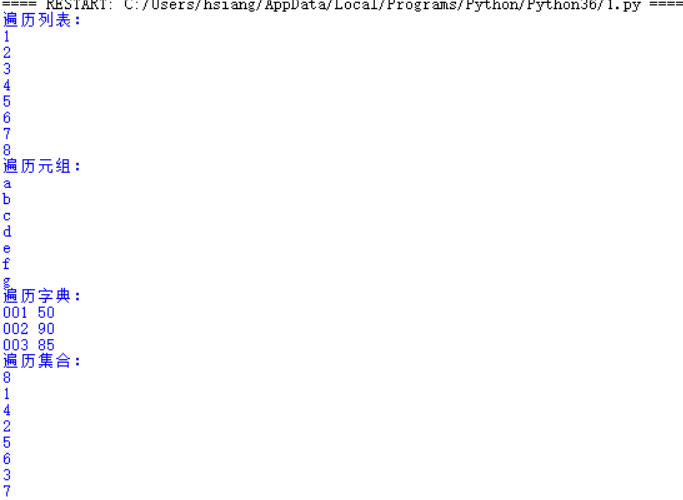1.字典实例:建立学生学号成绩字典,做增删改查遍历操作。
d={'001':'90','002':'80','003':'75','004':'65','005':'85'}
print(d.get('001'))
d.pop('002')
d['003']=65
for i in d:
print(i)

2.
列表,元组,字典,集合的遍历。
总结列表,元组,字典,集合的联系与区别。
l=list('12345678')
print('遍历列表:')
for i in l:
print(i)
t=tuple('abcdefg')
print('遍历元组:')
for i in t:
print(i)
d={'001':50,'002':90,'003':85}
print('遍历字典:')
for i in d:
print(i,d[i])
s=set(l)
print('遍历集合:')
for i in s:
print(i)

1.列表是任意对象的序列,用方括号表示。
2.将一组值打包到一个对象中,称为元组。元组用圆括号表示.元组和列表的大部分操作相同。但是,列表是不固定的,可以随时插入,删除;而元组一旦确认就不能够再更改。所以,系统为了列表的灵活性,就需要牺牲掉一些内存;而元组就更为紧凑。
3.集合是无序的,也不能通过索引进行访问且集合中的元素不能重复。
4.字典就是一个关联数组或散列表,其中包含通过关键字索引的对象。用大括号表示。与集合相比,通过关键字索引,所以比集合访问方便。
3.英文词频统计实例
A.待分析字符串
B.分解提取单词
a.大小写 txt.lower()
b.分隔符'.,:;?!-_’
c.单词列表
C.单词计数字典
s='''You were my everythingthis goes out to someone that was
once the most important person in my life
i didn't realize it at the time
i can't forgive myself for the way i treated you so
i don't really expect you to either
it's just... i don't even know
just listen...
you're the one that i want, the one that i need
the one that i gotta have just to succeed '''
s=s.lower()
for i in ',':
s=s.replace(i,' ')
w=s.split(' ')
print(w)
dict={}
for i in w:
dict[i]=w.count(i)
print(dict)

